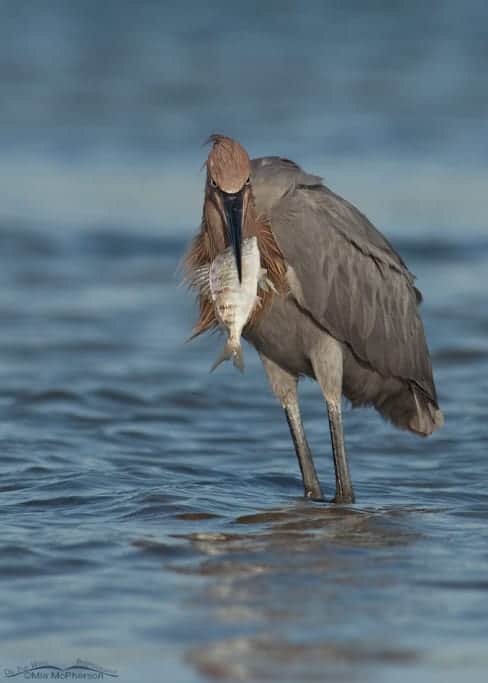I photographed this Reddish Egret (Egretta rufescens)in October of 2008 at Fort De Soto’s north beach. At that timeI was sitting in the water taking images of Great Egrets and some Laughing Gulls when the egret flew in and began fishing in the warm, shallow lagoon. It didn’t take the bird long to catch this fish.
The other birds in the area appeared to be quite interested in the egret’s prey and the egret had a difficult time swallowing it but after about 5 minutes it was finally able to do so. The prey is swallowed head first so those sharp spines of the fins are compressed.
There are only between 1,500 and 2,000 nesting pairs of Reddish Egrets in the United States and theirnumbers are being threatened by habitat destruction. I’m sure their population also took a dive after the Deepwater Horizon oil spill since they are primarily a coastal wading bird and are found along the shorelines of Florida, Alabama,Mississippi, Louisiana and Texas, all of which were impacted by the oily sludgethat coatedthe surface of the Gulf of Mexico, the beaches, marshes and tidal lagoons. And oil companies want more drilling platforms in the Gulf?

I think the CEO’s of the huge oil companies that have caused spillsshould have to live with oil surrounding their fabulous mansions and forced to raise their families in the same horrible conditionsthat the birds and other wildlife have been subjected to, perhaps they would be more careful. I can dream, right?
I am away for a few days, please feel free to share this post with your friends and family. I’ll catch up on everyone’s great blogs when I get back!
MiaOnTheWingPhotography
Mia McPherson
Mia McPherson is a nature lover, wildlife watcher and an avian photographer. Mia first become serious about bird photography when she moved to Florida in 2004. Her recent move to the Salt Lake area of Utah was a great opportunity to continue observing their behavior and photographing them. With so many birds species there easily accessible it wasn’t long before she was hooked. By learning more about each species, she can anticipate their behaviour and create opportunities to obtain ever better images of those species.
- Web |
- More Posts(85)
Leave a Reply